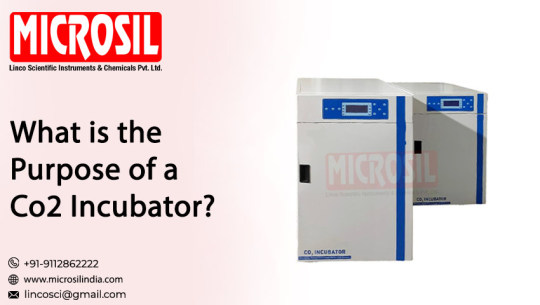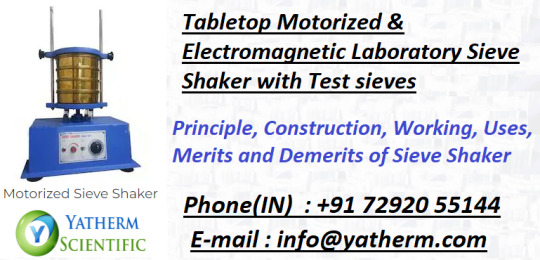#Co2 Incubator Manufacturers
Explore tagged Tumblr posts
Text
What is the Purpose of a Co2 Incubator?

CO2 incubators provide optimal conditions for cell culture, maintaining precise levels of temperature, humidity, and carbon dioxide. These controlled environments support cell growth and viability, crucial for various research and clinical applications. With advanced features like direct heat and infrared sensor technologies, they ensure uniform and stable conditions, fostering reproducible results. Microsil India offers high-quality CO2 incubators designed to provide the ideal environment for cell culture growth. Trust Microsil India for reliable CO2 incubators that ensure optimal conditions for your research and experimentation needs.
#Scientific Instruments Manufacturers in India#Scientific Instruments Suppliers in India#Laboratory Equipment Manufacturers#Laboratory Equipment Suppliers in India#Co2 Incubator#Co2 Incubator Manufacturers#Co2 Incubator Manufacturers in India#Top Co2 Incubator Manufacturers in India#Best Co2 Incubator Manufacturers in India
0 notes
Text
#BOD Incubator#BOD Incubator exporter#Biochemical Oxygen Demand#Biochemical Oxygen Demand Incubator#BOD Incubator Supplier#CO2 Incubator Manufacture#Maharashtra#Manufacture#Exporter#India
0 notes
Text

We are Delhi based leading manufacture & Supplier of CO2 Incubators in India.
0 notes
Text

Labtron Air Jacketed CO2 Incubator LAJI-C10 offers outstanding temperature stability. provides a heating method that is air-jacketed.Temperature Range: RT+5 °C to 50 °C. Temperature Gradient: ≤ ± 0.5 °C. Electrical Requirement: AC220 V, 50 Hz Power Consumption: 400 W. ISO Class 5 chamber with air renewal system. humidity sensor with water top-up alarm Meets sterilization of 99.99% with 80°C heat on cells. CO2 pressure-relief valve with 2-stage control and stable pressure.
#Science lab co2 incubator manufacturers in Girdwood alaska usa#Science lab co2 incubator manufacturers in Wrangell alaska usa#Science lab co2 incubator manufacturers in Nikiski alaska usa
0 notes
Text
CO2 Incubator Troubleshooting: Common Problems and Solutions
Is your CO2 incubator giving you trouble? Check out this guide for common problems and solutions to keep your experiments running smoothly.
A CO2 incubator is a crucial piece of equipment for many scientific experiments, but it can be frustrating when it's not working properly. This guide will help you troubleshoot common issues with your CO2 incubator and provide solutions to keep your experiments running smoothly.

Temperature fluctuations
One common problem with CO2 incubators is temperature fluctuations. This can be caused by a variety of factors, including a malfunctioning thermostat, a faulty heating element, or poor insulation. To troubleshoot this issue, first check the thermostat and make sure it is set to the correct temperature. If the thermostat is working properly, check the heating element and make sure it is functioning correctly. If neither of these solutions work, it may be necessary to replace the insulation or contact a professional for further assistance.
CO2 level fluctuations
Another common problem with CO2 incubators is fluctuations in CO2 levels. This can be caused by a variety of factors, including a malfunctioning CO2 sensor, a clogged gas inlet, or a leak in the system. To troubleshoot this issue, first check the CO2 sensor and make sure it is functioning properly. If the sensor is working correctly, check the gas inlet and make sure it is not clogged. If neither of these solutions work, it may be necessary to check for leaks in the system or contact a professional for further assistance.

Contamination
Contamination is a common problem in CO2 incubators and can be caused by a variety of factors, including improper cleaning, contaminated media or reagents, or a malfunctioning HEPA filter. To prevent contamination, it is important to regularly clean and disinfect the incubator and all equipment used inside. Additionally, make sure to use sterile media and reagents and regularly replace the HEPA filter. If contamination does occur, it may be necessary to discard any affected samples and thoroughly clean the incubator before starting again.
Read more: Co2 Incubator-About, Benefits & Where to Buy
Water accumulation
Water accumulation is a common problem in CO2 incubators and can be caused by a variety of factors, including condensation from high humidity levels or a malfunctioning water pan or drain. To prevent water accumulation, make sure to regularly check and empty the water pan and ensure that the drain is functioning properly. Additionally, reducing the humidity levels in the incubator can help prevent condensation. If water accumulation does occur, it is important to thoroughly clean and disinfect the affected areas to prevent contamination.
Door seal issues
One common problem with CO2 incubators is door seal issues. If the door seal is not functioning properly, it can lead to temperature and humidity fluctuations, which can negatively impact your experiments. To check for door seal issues, inspect the seal for any cracks or gaps. If you notice any issues, try cleaning the seal with a mild detergent and warm water. If the problem persists, you may need to replace the seal. It is important to address door seal issues promptly to ensure the integrity of your experiments.
1 note
·
View note
Text
The Future of Autism Care: Global Cell Culture Incubator Market
The cell culture incubator market is on track for substantial expansion, with a projected value of USD 2,315.5 million in 2023. Over the next decade, the market is expected to double in value, reaching an impressive USD 4,305.1 million by 2033. This growth will be driven by a Compound Annual Growth Rate (CAGR) of 6.4% during the forecast period, building upon a solid foundation of 5.6% CAGR observed from 2018 to 2022.
Cell culture incubators play a critical role in scientific research, pharmaceutical development, and biotechnology applications, providing controlled environments for cell growth, maintenance, and experimentation. As the demand for cell-based research and biopharmaceutical production continues to rise, the market for cell culture incubators is experiencing robust growth.
Request Your Detailed Report Sample With Your Work Email: https://www.futuremarketinsights.com/reports/sample/rep-gb-4392
Bacteria and cell cultures are kept growing inside a chamber at carefully regulated temperature, humidity, pH, and CO2 concentration by a device called a cell culture incubator. The demand for more vaccines based on cell culture and its subsequent approvals are fueling the market for cell culture incubators. The rising prevalence of chronic illnesses and the growing need for monoclonal antibodies are predicted to drive growth in the target market.
A specialized scientific tool for the meticulously regulated development and preservation of cells is a tissue culture incubator. To promote the ideal conditions for cell formation and proliferation, it offers stable settings with regulated temperature, humidity, and gas concentrations.
Market Competition:
The key players of this market include Thermo Fisher Scientific Inc, Memmert GmbH + Co.KG, Binder GmbH, Panasonic, BioIVT, Sheldon Manufacturing, Inc.
Thermo Fisher Scientific Inc. announced in June 2021 that the company’s Thermo Scientific Cytomat 24 automated incubators and storage systems are combined with the latest technology to aid increased throughput and sample protection. The new Cytomat 24 automated incubators and storage systems from Thermo Fisher Scientific, which will be available in May 2021, provide a large capacity, quick access, and a wide temperature range while minimizing contamination difficulties in high-throughput applications. The new instruments use temperature consistency and stability to assure reproducibility for cell culture applications, while also providing speedy delivery of microtiter plates via an enhanced plate shuttle system, according to a press release issued by Thermo Fisher on May 14, 2021. The system also incorporates an LED touch screen that is installed on the door for easy access and viewing.
BioIVT released its GMP Grade Human AB Serum tailored for gene therapy manufacturing in January 2022. BioIVT’s GMP-grade human AB serum is manufactured with the same optimized processes and improved regulatory control of source material collection, manufacturing, and processing as its research-use only material. However, it also includes extra viral tests and documentation for hepatitis A (plasma-derived only), hepatitis B core antibody, hepatitis E, and parvovirus B19 (plasma-derived only).
Key Segments Profiled In The Cell Culture Incubator Industry Survey:
By Type:
Air-jacketed
Water-jacketed
Direct Heat
By Sensor Technology:
Infra-red
Thermal Conductivity
By Application:
For Pharmaceutical Applications
For Biomedical and Clinical Labs
For Government Research
For IVF Processes
For Other Applications
By Region:
North America
Latin America
Europe
Asia Pacific
Middle East & Africa
0 notes
Text
Check the Best Quality Blood Culture Specimen Collection (TMC 074) at TM Media
If you are looking for blood culture specimen collection (TMC 074) manufactured by TM Media automates the process of detecting microbial growth in blood samples. It typically consists of a sterile chamber where blood culture bottles are incubated and monitored for bacterial or fungal growth. The instrument continuously scans the bottles for signs of growth, such as changes in CO2 levels or turbidity. Once growth is detected, the instrument alerts laboratory staff, facilitating prompt identification of bloodstream infections. This automated system improves efficiency, reduces manual labor, and enhances the accuracy of blood culture analysis, leading to faster diagnosis and appropriate treatment of infections.
Visit the Website - https://www.tmmedia.in/

0 notes
Text
Exploring the Evolution of Laboratory Ovens: Precision, Efficiency, and Innovation
Laboratory ovens are indispensable tools in scientific research, pharmaceuticals, and industrial applications, providing controlled heating environments for various processes such as drying, curing, sterilization, and testing. Over the years, these ovens have undergone significant advancements, driven by the need for precision, efficiency, and innovation.
Precision is crucial in laboratory operations, and modern laboratorium oven are equipped with advanced temperature control systems that ensure precise and uniform heating. Microprocessor-based controllers, thermocouple sensors, and PID algorithms enable users to set and maintain precise temperature levels with minimal fluctuations, ensuring consistent and reliable results.
Efficiency is another key consideration in laboratory operations, and manufacturers have made significant strides in improving the energy efficiency of laboratory ovens. Insulated chambers, sealed doors, and energy-efficient heating elements minimize heat loss and reduce energy consumption, making modern ovens more environmentally friendly and cost-effective to operate.
Innovation drives the evolution of laboratory ovens, pushing the boundaries of what is possible in terms of functionality and performance. Recent innovations include the integration of touchscreen interfaces, programmable controls, and remote monitoring capabilities, allowing users to easily program and monitor oven operations from anywhere. Additionally, the introduction of multi-functional ovens that combine heating, drying, and sterilization capabilities in a single unit provides greater versatility and efficiency in laboratory workflows.
Safety is a paramount concern in laboratory settings, and manufacturers have implemented various safety features to protect users and samples. These features may include overtemperature protection, door interlocks, and alarms to alert users of any deviations from set parameters, ensuring safe operation and preventing potential hazards.
Conclusion :
laboratory ovens have evolved significantly to meet the demands of modern scientific research, pharmaceuticals, and industrial applications. The latest advancements in precision, efficiency, innovation, and safety ensure that laboratory ovens remain essential tools for a wide range of heating and drying processes. As technology continues to advance, we can expect further enhancements that will drive the evolution of laboratory ovens and improve their functionality, performance, and usability.
For More Info :-
Co2 incubator
Incubator
0 notes
Text
Understanding the Importance of CO2 Incubator Shaker
Get the optimum CO2 cultivation environment for your cannabis grow with our CO2 incubator shaker!
0 notes
Text

Ambient Air Quality Monitoring System Manufacturers in India
The founders of KDM Global have more than 40 years of combined experience in the design, manufacture, marketing, and service of environmental test chambers. Their goal is to provide high-quality products at competitive prices while utilising creative cost-cutting measures.
KDM Global is a renowned manufacturer, exporter, and supplier of laboratory and scientific equipment of the highest calibre. We offer a variety of products, such as laboratory equipment, scientific equipment, low temperature equipment, clean room equipment, a laboratory autoclave that is vertical, a stability chamber, a humidity oven, an orbital shaker incubator, a vertical dehumidifier, a rotary shaker, a CO2 incubator, a fume chamber, a deep freezer, a blood bank refrigerator, and a UV inspection cabinet,Vertical Reverse Flow, Clean Air Pressure Modules, and Biological Safety Cabinets Bio-Hood. Powder Dispensing Booth. We have been able to keep up with the continuously changing requirements of numerous industries by drawing on our years of experience. Recent technological advancements have compelled us to create, customise, and manufacture equipment that meets the unique needs of various laboratories and governmental organisations. Due to our dedication to quality and adherence to international quality standards, we have been able to carve out a space for ourselves in this business internationally.
Our items are made from excellent materials that have been examined for effectiveness and sturdiness. Our highly skilled and knowledgeable employees can create the accessories to the clients' demands. Our product lines are made from premium materials that have been evaluated for their effectiveness and quality. They are created in accordance with the demands of the customers. We offer both carton and wooden packaging according on the needs of the products.
OUR PURPOSE
o In order to give creative solutions for product development and quality assurance, it is our objective to design, build, and supply dependable environmental test chambers in conjunction with our clients.
· As a well-known supplier of top-notch solutions in the reliability testing industry, to offer clients who are concerned about quality with solutions that are accurate, unbiased, and give them a competitive edge over their rivals.
o We are dedicated to offering our clients across the globe unrivalled customer service. We promise great customer service in terms of product delivery, product information, and online/offline support, whether it is a domestic or international firm.
o Motivate and educate our staff and channel partners about the value of our testing processes in the creation and dependability of our clients' products.
We monitor air quality because
Designing and producing the best air quality monitoring technology is at the heart of KDM Global's aim to strike a balance between development and preservation, which supports our dedication to fostering surroundings that are conducive to possibility.
The most fundamental goal of air quality monitoring is to protect lives and keep you safe from dangerous gases, greenhouse and trace gases, particles, dust, and smoke that may have a negative impact on your health, happiness, quality of life, and longevity.
For more details contact us:
Email : [email protected]
Website:https://kdmglobal.business.site , https://sites.google.com/view/kdmglobal/home
Contact :8218470498
0 notes
Link
Here you can find broad list of CO2 Incubator manufacturers, dealers and suppliers from India, as well as all Healthcare related products and services on Hospital Product Directory.
0 notes
Text
Incubator Manufacturer in India

With an emphasis on cost-effective yet efficient products, Indian incubator companies are focused on providing high-quality and reliable equipment for clinical and research purposes. These manufacturers offer a range of different types of incubators including microbiological, neonatal, cell culture and CO2 incubators. Microsil India ( Linco Scientific ) is one of the leading incubator manufacturer in India. They are designed to provide a safe, controlled environment for the growth and development of cells, tissues, and organisms. Contact for more!
Visit: https://www.microsilindia.com Contact: +91-9112862222 Mail: [email protected]
#Incubator Manufacturer in India#Best Incubator Manufacturer#Top Incubator Manufacturer#Incubator Manufacturing Company in India#Best Incubator Manufacturing Company#Top Incubator Manufacturing Company#Incubator Manufacturers in India#Best Incubator Manufacturers#Top Incubator Manufacturers
0 notes
Text

#BOD Incubator#BOD Incubator exporter#Biochemical Oxygen Demand#Biochemical Oxygen Demand Incubator#BOD Incubator Supplier#CO2 Incubator Manufacture#Maharashtra#Manufacture#Exporter#India
0 notes
Link

Here you can find broad list of CO2 Incubator manufacturers, dealers and suppliers from India, as well as all Healthcare related products and services on Hospital Product Directory.
0 notes
Text
#co2 incubator Suppliers in India#co2 incubator Manufacturers in India#co2 incubator product directory#co2 incubator#co2 incubator Suppliers#co2 incubator Manufacturers
0 notes
Text

Yatherm manufactures customized Orbital shaker, VDRL Shaker, rotary flask shaker, co2 incubator shaker, Wet Sieve shaker Yoder type, Sedimentation shaker, incubator shaker & Tabletop electromagnetic laboratory sieve shaker machine for Research applications.
https://www.youtube.com/watch?v=ntA9EN1tdmo
0 notes